|
BumblebeeID
- find British species by colour pattern
Distinguishing
similar species:
As a cuckoo
bee with no pollen baskets (corbiculae) on the hind legs (see
Prys-Jones & Corbet, 1987,
1991) and with this colour pattern and dark wings, B. rupestris
females are unmistakable in Britain; males can be distinguished
by their
genitalia.
'Hill
Cuckoo-bee'
(Step, 1932)
'Red-tailed
cuckoo bee'
(BBCT)
taxonomy
and nomenclature
|
The
least widespread and abundant British cuckoo bee, restricted
to the south, often with large females, and emerging late
in spring.
|
| Habitat |
Breeds
in colonies of B.
lapidarius, to which it bears a striking resemblance
(see Reinig, 1935).
|
|
British
distribution
|
England,
Wales and Scottish borders, absent from most of Scotland.
M. Edwards and E. Philp (in Edwards & Telfer, 2001)
conclude that after a period of decline, this species is becoming
more abundant. Data from Alford (1980)
are mapped on a 10 km grid (left) to show local patchiness
and on a 50 km grid (right) to show changes in the regional
pattern (dark blue - post 1960; light blue - pre 1960 only):
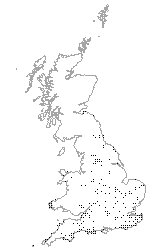 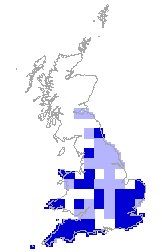
|
| Worldwide
distribution |
Europe
and Asia, including the eastern Tibetan plateau,
to the Pacific. World distribution mapped on an
equal-area grid
(dark
blue - specimens identified by PHW; light blue -
literature records; white - expected distribution):
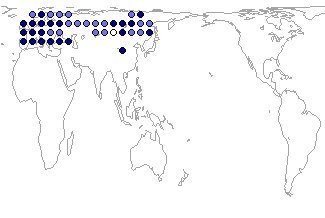
|
Distinguishing
similar species:
Unlike
B. bohemicus, B.
vestalis have (1) short even hair and (2) golden
yellow bands. Against other species, males can be distinguished
by their
genitalia.
'Vestal
Cuckoo-bee'
(Step, 1932)
'Southern
cuckoo bee'
(BBCT)
taxonomy
and nomenclature
|
Widespread
and common in the south, often with large females, and emerging
in early spring. Males are often abundant in suburban gardens.
|
| Habitat |
Breeds
in colonies of B.
terrestris.
|
|
British
distribution
|
England,
Wales, north to the Scottish borders, absent from most of
Scotland. Data from Alford (1980)
are mapped on a 10 km grid (left) to show local patchiness
and on a 50 km grid (right) to show changes in the regional
pattern (dark blue - post 1960; light blue - pre 1960 only):
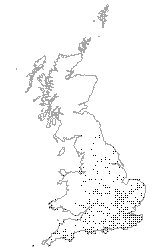 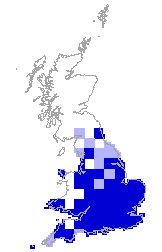
|
| Worldwide
distribution |
Central
and southern Europe, north Africa, east to Iran. World distribution
mapped on an equal-area grid
(dark
blue - specimens identified by PHW; light blue - literature
records; white - expected distribution):
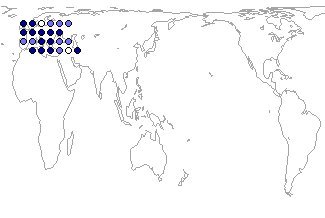
|
|
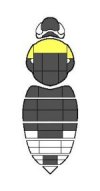
female
|
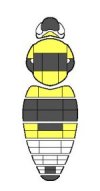
male
|
|
|
|
Distinguishing
similar species:
Unlike
B. vestalis, B. bohemicus
have (1) long hair and (2) lemon-yellow bands. Against
other species, males can be distinguished by their
genitalia.
'Gipsy
Cuckoo-bee'
(Step, 1932)
'Gypsy
cuckoo bee'
(BBCT)
taxonomy
and nomenclature
|
Widespread
and common in the north, often with large females, and emerging
in early spring.
|
| Habitat |
Breeds
in colonies of B.
lucorum.
|
|
British
distribution
|
Throughout
Britain, more frequent in the north and rare in the lowlands
of the southeast, absent from the Scilly Isles and Shetland.
Data from Alford (1980)
are mapped on a 10 km grid (left) to show local patchiness
and on a 50 km grid (right) to show changes in the regional
pattern (dark blue - post 1960; light blue - pre 1960 only):
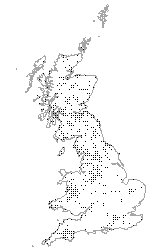 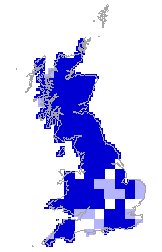
|
| Worldwide
distribution |
Europe
and Asia, including the Himalaya, to the Pacific. World distribution
mapped on an equal-area grid
(dark
blue - specimens identified by PHW; light blue - literature
records; white - expected distribution):
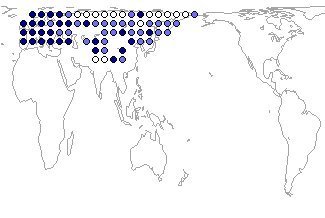
|
Distinguishing
similar species:
As
a cuckoo bee with no pollen baskets (corbiculae) on
the hind legs (see Prys-Jones & Corbet, 1987,
1991) and with this colour pattern, B. barbutellus
females are unmistakable in Britain; males can be distinguished
by their
genitalia.
|
'Barbut's
Cuckoo-bee'
(Step, 1932)
'Barbut's
cuckoo bee'
(BBCT)
taxonomy
and nomenclature
|
Widespread
but often not common, even in the south, of medium body
size, emerging in late spring.
|
| Habitat |
Breeds
in colonies of B.
hortorum.
|
|
British
distribution
|
Throughout
much of Britain, less frequent in the north, except absent
from the Scilly Isles and Shetland. Data from Alford (1980)
are mapped on a 10 km grid (left) to show local patchiness
and on a 50 km grid (right) to show changes in the regional
pattern (dark blue - post 1960; light blue - pre 1960 only):
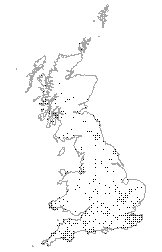 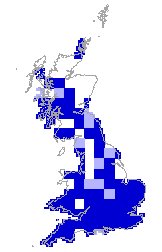
|
| Worldwide
distribution |
Europe
and northern Asia to the Pacific. World distribution mapped
on an equal-area grid (dark
blue - specimens identified by PHW; light blue - literature
records; white - expected distribution):
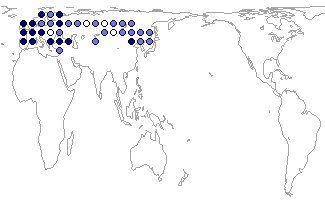
|
The dark form
is widespread, but occurring at low frequency, and is
more common amongst males. The very pale form occurs
in western Scotland.
Distinguishing
similar species:
As
a cuckoo bee with no pollen baskets (corbiculae) on
the hind legs (see Prys-Jones & Corbet, 1987,
1991) and with this colour pattern, B. campestris
females are unmistakable in Britain; males can be distinguished
by their
genitalia.
'Field
Cuckoo-bee'
(Step, 1932)
'Field
cuckoo bee'
(BBCT)
taxonomy
and nomenclature
|
Widespread
and common, of medium body size, emerging in late spring.
|
| Habitat |
Breeds
in colonies of B.
pascuorum.
|
|
British
distribution
|
Throughout
Britain, except absent from parts of Scotland, the Scilly
Isles and Shetland. Data from Alford (1980)
are mapped on a 10 km grid (left) to show local patchiness
and on a 50 km grid (right) to show changes in the regional
pattern (dark blue - post 1960; light blue - pre 1960 only):
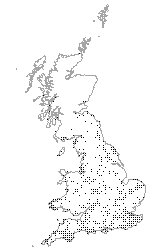 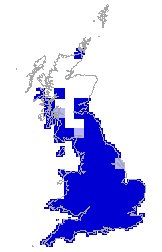
|
| Worldwide
distribution |
Europe
and northern Asia to the Pacific. World distribution mapped
on an equal-area grid (dark
blue - specimens identified by PHW; light blue - literature
records; white - expected distribution):
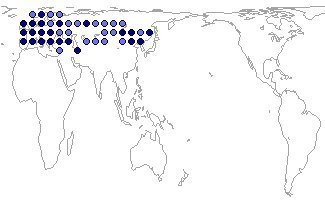
|
Distinguishing
similar species:
As
a cuckoo bee with no pollen baskets (corbiculae) on
the hind legs (see Prys-Jones & Corbet, 1987,
1991), with this colour pattern, and with the tip
of the abdomen curled underneath to point forwards,
B. sylvestris females are unmistakable in Britain;
males can be distinguished by their
genitalia.
'Four-coloured
Cuckoo-bee'
(Step, 1932)
'Forest
cuckoo bee'
(BBCT)
taxonomy
and nomenclature
|
Widespread
and common, of small body size, emerging in early spring.
The males are the first cuckoo males to appear each year.
|
| Habitat |
Breeds
in colonies of B.
pratorum and B.
jonellus (see Richards, 1928).
|
|
British
distribution
|
Throughout
Britain, except absent from parts of Scotland, the Scilly
Isles and Shetland. Data from Alford (1980)
are mapped on a 10 km grid (left) to show local patchiness
and on a 50 km grid (right) to show changes in the regional
pattern (dark blue - post 1960; light blue - pre 1960 only):
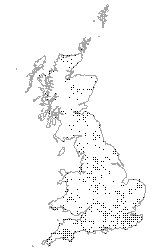 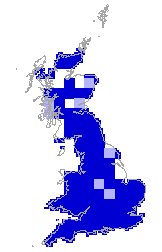
|
| Worldwide
distribution |
Europe
and northern Asia to the Pacific. World distribution mapped
on an equal-area grid (dark
blue - specimens identified by PHW; light blue - literature
records; white - expected distribution):
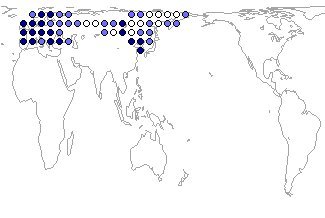
|
alphabetic
British list | distribution
of British species | colour
patterns | colour
diagrams
 top of page
top of page
|